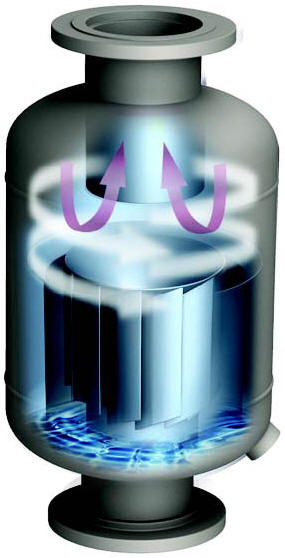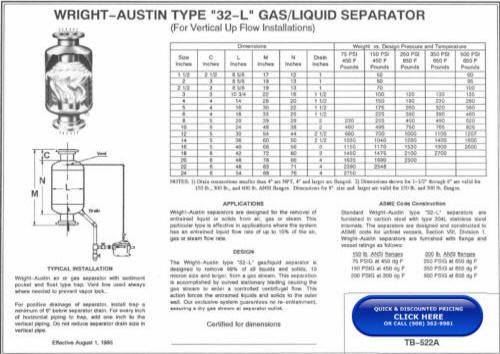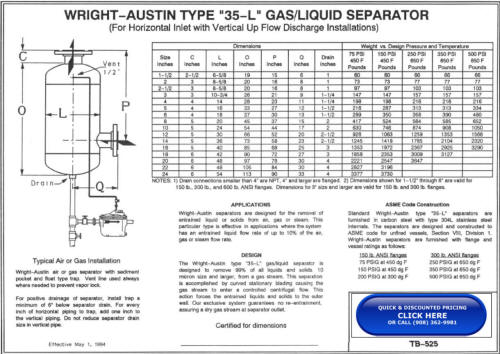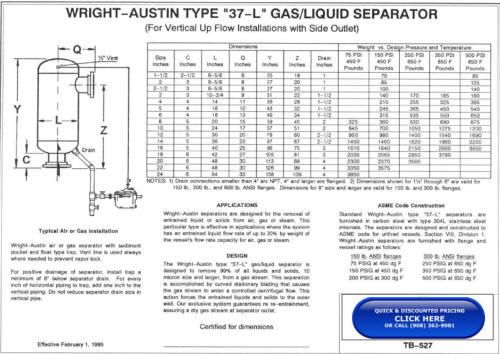- The Company
- Articles
- Coalescer Gas Liquid Separator Designs
- Comparison of Centrifugal and Vane Style Gas Liquid Separators
- Design & Capabilities of Gas Liquid Separators
- Differences of a Knock-Out Drum and Centrifugal Gas-Liquid Separator
- Exhaust Head Design
- How float drain traps work, installation and maintenance
- How to identify a Wright-Ausin Separator
- How to Size a Moisture Separator
- Steam Traps vs. Steam Separators
- Efficiencies of Centrifugal Separators
- Understanding Sizing Factors For Gas/Liquid Separators
- Horizontal
- Vertical
- High Solids
- Coalescer
- Elements
- Exhaust Heads
- Float drain traps
- Liquid level gauges
- Sizing Calculators
- Inquiries
30L Style Vertical Gas Liquid Separators
Gas liquid separators for vertical upflow applications
 The
Wright-Austin 30L series of in-line vertical gas/liquid separators
remove 99% of droplets and particles equal to or greater than 10
microns in a very compact design. As the moisture laden gas
enters the separator, it encounters a curved, stationary blading
structure welded to the inside of the vessel which causes a
powerful vortex, propelling the droplets to the outer wall.
The liquid coalesces and exits the separator's drain.
The
Wright-Austin 30L series of in-line vertical gas/liquid separators
remove 99% of droplets and particles equal to or greater than 10
microns in a very compact design. As the moisture laden gas
enters the separator, it encounters a curved, stationary blading
structure welded to the inside of the vessel which causes a
powerful vortex, propelling the droplets to the outer wall.
The liquid coalesces and exits the separator's drain.
As with all Wright-Austin gas/liquid separators, there are no moving
parts, they are self-cleaning and require no maintenance.
Wright Austin gas liquid separators employ a patented Vortex
Containment Plate (VCP) and combined with centrifugal action assures
maximum separation of entrainment with minimal chances of
reentrainment. Wright Austin accomplished this without complex
baffles, deflectors and other structures that obstruct the
flow-stream, resulting in very low pressure drops compared to vane
and other designs.
What is the minimum velocity
required through our separators?
There is no minimum velocity requirement for our
separators. Wright-Austin has run many tests over the years that
support this contention. There are several characteristics causing
separation. When the units are used at or near their maximum
capacities, the primary cause for separation is centrifugal force,
causing the liquid droplets to move to the outer walls. When the
flow is reduced the following characteristics dominate the
separation process: Expansion/gravity, Agglomeration and Directional
change.
Expansion/Gravity
The air,
gas or steam expands in the vessel after leaving the inlet nozzle.
This slows down the velocity at which the media and liquid molecules
are moving. The liquid droplets tend to bump into each other and
form larger droplets. The larger droplets are more likely to fall
out due to gravity especially since the speed at which they are
moving has also been reduced.
Agglomeration on surface
Droplets that form on the interior surfaces attract (agglomerate)
more droplets. Big droplets fall to the bottom and drain out.
Change in Direction: The air, gas or steam flow changes directions (although slowly) inside the vessel in order to exit through the outlet nozzle. A change in flow direction shears off some liquid droplets that cannot make the turn.
All Wright-Austin Model 30L series air liquid separators are available with ASME code stamp in accordance with ASME Section VIII, Division I and CRN.
Wright-Austin Type 32L Vertical Gas-Liquid Separator Drawing (click to open full size PDF link)
If your flow path is horizontal, review the 30L Style Horizontal Gas/Liquid Separator page.






